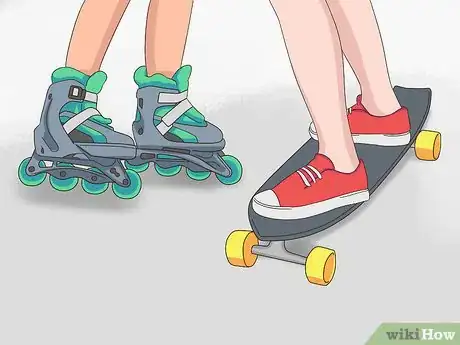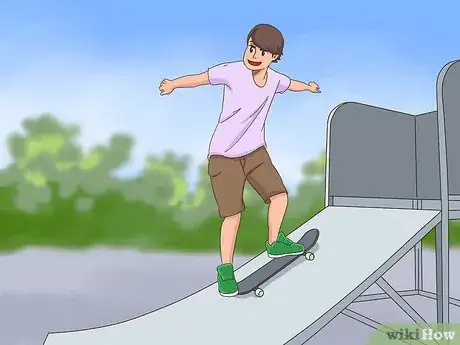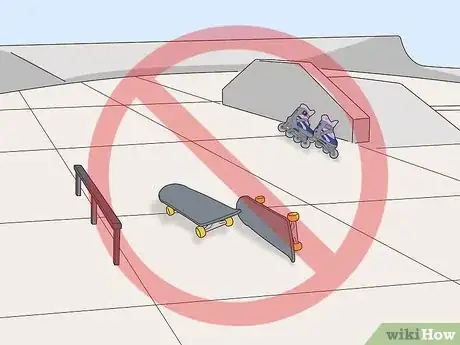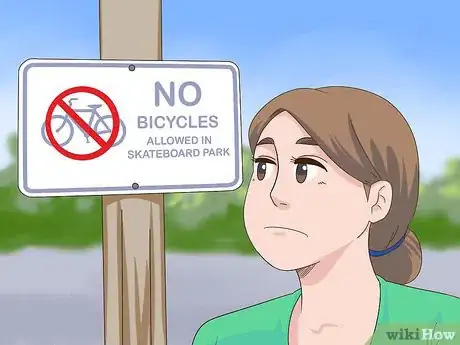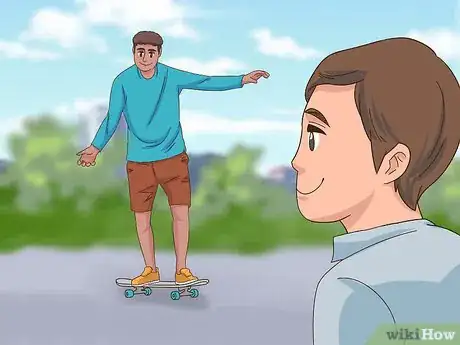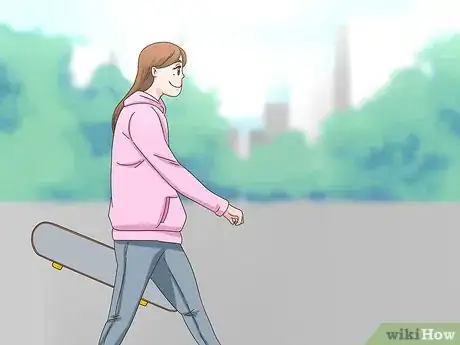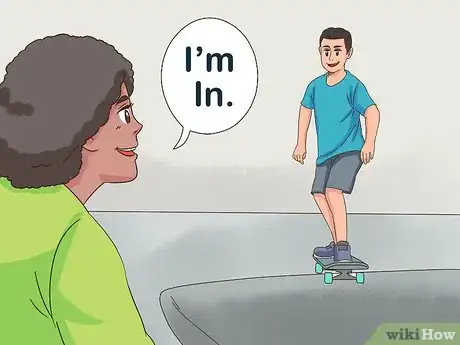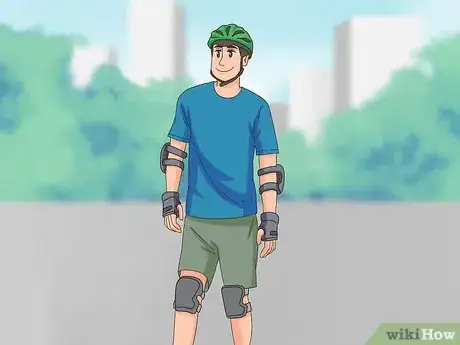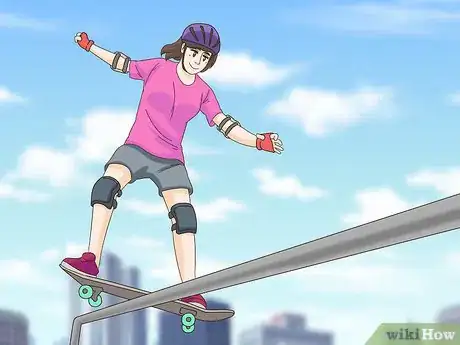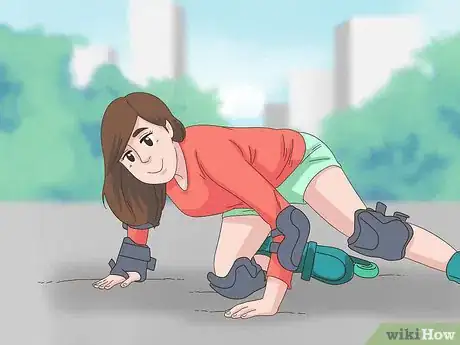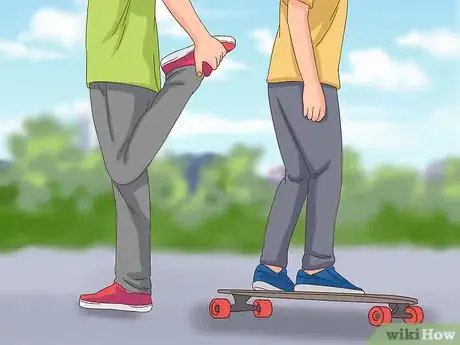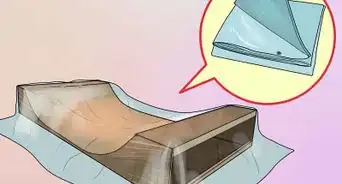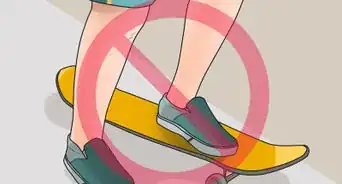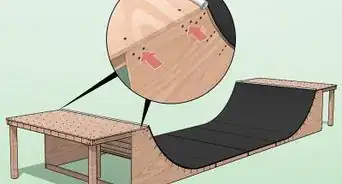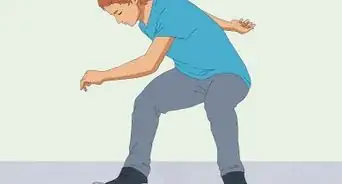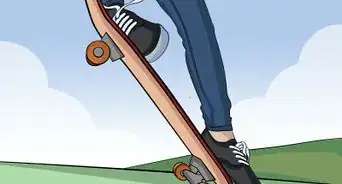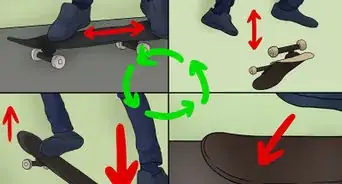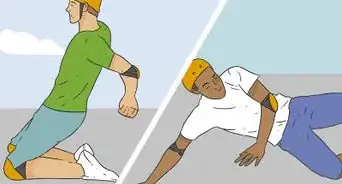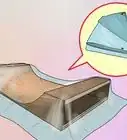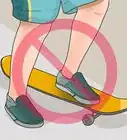This article was co-authored by Jon Depoian. Jon Depoian is a Skateboarding Instructor and the Owner of Intro2Skateboarding, an organization based in Orange County, California that provides professional private, home-school, after-school, birthday party, and summer camp skateboard lessons for beginners and experienced skateboarders alike. Jon has over 21 years of skateboarding experience and over 10 years of skateboard instruction experience. He also has extensive experience producing street skateboarding videos and skating competitions.
This article has been viewed 122,493 times.
You've been skateboarding on your sidewalk, parking lots, and school yards, but not the skatepark. Going to a skatepark for the first time can be scary and intimidating, but practicing basic skating skills beforehand can help to build confidence before you tackle skatepark equipment. Learning proper park etiquette, how to skate around others to avoid causing accidents, and being sure to practice safety while skating will make sure you have a great experience when you take the trip to a skatepark.
Steps
Having Proper Skatepark Etiquette
-
1Learn the basics of skateboarding or roller skating before going to a skatepark. You should be at least an intermediate level before you attempt going to the skatepark. Practice on your board or skates by yourself, learning how to balance and stay upright while in motion, and jump with them.[1]
- Be sure to know the basics of riding the board and at least one trick you can do. A few good tricks to know are the ollie, the pop shuvit, and the kickflip.
-
2Take short and sweet turns on the equipment. One “run” on a piece of the park’s equipment should not last for longer than a minute, or you will be tying up the line of other skaters wishing to go. Especially if you’re just going through the basics, try to get a few tricks in under that time, before coming back and getting in line again if you would like another run.
- A long run is alright on occasion, but not every time. If you do go for a long one, make sure you time it right so you’re not blocking off anyone else. If it’s a run through multiple pieces of equipment, be careful not to cut anyone off as you move along.
Advertisement -
3Keep the park equipment clear. Although it may be alright to temporarily sit on a ledge or a bench, most flat surfaces in the park are there to be skated on. Move your gear out of the way of the equipment to avoid any other skaters from tripping over it. See where any other skaters who are taking a break are, and join them if you need somewhere to stand around in between runs.[2]
- If you can’t find a spot in the park to take a break, going outside of it will have places you can rest where you won’t have to worry about blocking other skaters.
-
4Find out if your skatepark allows bicycles before riding one there. Some city’s skateparks, such as Seattle’s, don’t allow bikes to be used in them. If your local skatepark allows bikes, make sure it doesn’t have metal pegs on the front or back wheels that can damage the equipment. A bike is a lot larger and more damaging than a skateboard or someone on skates if it’s involved in a collision, so be sure to avoid others while performing tricks.[3]
- Wash the tires of your bike if they have dirt or mud on them before you come to the skatepark.
-
5Be inclusive towards everyone who is at the park. Everyone is entitled to the space, no matter if they’re on a board, skates, scooter, or bike (if it’s allowed). It should go without saying, but don’t say someone shouldn’t be at a skate park based on their race, ethnicity, gender, or sexual orientation. Anybody who wants to be there should be allowed to be there.
Skating around Others
-
1Go to the skatepark in the morning to avoid crowds. Afternoons and after school especially will be busy periods for a park, so if you want to practice when there are less people, try going in the mornings before 10:00 AM. Certain parks may also be busy certain days and dead on others, while it may be the reverse for another park nearby.[4]
- Go when the crowd size makes you most feel most comfortable: less packed for beginners, more dense as you get better.
-
2Take your turn to not cut others off as they skate. Cutting someone off is called “snaking,” and it’s the most common cause of collisions. Wait as the other skaters use a piece of equipment before taking your turn. Learn the rhythm for when you should go and how long you should take each time.[5]
- Apologize to anyone who you accidentally snake and try to avoid it as much as possible, or risk getting a bad reputation in the park.
-
3Call out to other skaters if you plan to skip or take your turn. Don’t linger on the edge of the bowl or the lead up to a ramp, as others will be trying to skate there. If you’re waiting your turn and decide not to go, say “Dropping.” If you’re off to the side and want to take your turn tell the others there “I’m in.”
- Always do your best to telegraph your actions to the other skaters before you make them.
- Call out “Board!” to other skaters who might get in your way while skating to let them know you’re there.
Practicing Safety
-
1Wear the proper skating gear. You’ll thank yourself later when you fall over numerous times practicing a new move by wearing elbow and knee pads, wrist guards, and a helmet. Properly fitted skates should be worn that are sturdy and offer good ankle support, and should always be buckled securely. Wear a mouth guard to keep your teeth safe through each fall.[6]
- Check the wheels on your board or skates to make sure they’re firm and tight, as well as not damaged. If your wheels are in a state that would compromise your ride, replace them immediately.
-
2Perform only what you’re comfortable with pulling off. Work your way up the skill level of the equipment your park has until you master each, before moving onto the next. Try out a mini ramp when you first get there, before working up to the larger, shared vert ramp (AKA “the bowl”).
- If you ask other skaters for help, make sure you pay attention: they don't want to spend their whole time helping you, but will be willing to give you some useful tips.
-
3Get up quickly if you fall. If you’re not injured from failing a trick, you should get up as soon as possible to prevent being struck by another skater. If you’re seriously hurt, let others know so they can help you or get medical assistance.[7]
-
4Warm up before and cool down after skating. Start out your routine each time by stretching on your board and seeing the different ways you can manipulate your body on it while keeping balance, potentially to make a new trick. Try it at first while in place, then in motion, and perhaps let it serve as a good launching point for what you want to practice that day.
- When you’re coming down, skate around gently for a bit before stopping and doing some in place stretches with your arms and legs.
Expert Q&A
-
QuestionShould I go to a skatepark if I'm a beginner?
 Jon DepoianJon Depoian is a Skateboarding Instructor and the Owner of Intro2Skateboarding, an organization based in Orange County, California that provides professional private, home-school, after-school, birthday party, and summer camp skateboard lessons for beginners and experienced skateboarders alike. Jon has over 21 years of skateboarding experience and over 10 years of skateboard instruction experience. He also has extensive experience producing street skateboarding videos and skating competitions.
Jon DepoianJon Depoian is a Skateboarding Instructor and the Owner of Intro2Skateboarding, an organization based in Orange County, California that provides professional private, home-school, after-school, birthday party, and summer camp skateboard lessons for beginners and experienced skateboarders alike. Jon has over 21 years of skateboarding experience and over 10 years of skateboard instruction experience. He also has extensive experience producing street skateboarding videos and skating competitions.
Skateboarding Instructor It's not a good idea to go to the skatepark if you're still learning how to ride. Start out by learning how to ride on a tennis court or basketball court so that you get a sense for how to balance, turn, and fall on a smooth surface. Once you've mastered the basics, then you can head out to the skatepark.
It's not a good idea to go to the skatepark if you're still learning how to ride. Start out by learning how to ride on a tennis court or basketball court so that you get a sense for how to balance, turn, and fall on a smooth surface. Once you've mastered the basics, then you can head out to the skatepark. -
QuestionWhat if I'm alone and none of my mates are there?
 Community AnswerJust walk up to some skaters that seem to be your age and ask them if they want to play the game of S.K.A.T.E. It's the game where you do a trick and the other skater has to make the same trick. If one skater doesn't land a trick he gets a letter (S.K.A.T.E.). If you have all letters of the word skate you've lost the game. You decide who pops the first trick via ro sham bo; it's like paper, scissors, rock but for skaters.
Community AnswerJust walk up to some skaters that seem to be your age and ask them if they want to play the game of S.K.A.T.E. It's the game where you do a trick and the other skater has to make the same trick. If one skater doesn't land a trick he gets a letter (S.K.A.T.E.). If you have all letters of the word skate you've lost the game. You decide who pops the first trick via ro sham bo; it's like paper, scissors, rock but for skaters. -
QuestionHow old do I have to be to go to a skatepark?
 Community AnswerIf you are old enough to skate and understand and follow skatepark etiquette, then you are old enough to go to a skatepark. Keep in mind that if you are a child, you may want to bring an adult or an older sibling with you.
Community AnswerIf you are old enough to skate and understand and follow skatepark etiquette, then you are old enough to go to a skatepark. Keep in mind that if you are a child, you may want to bring an adult or an older sibling with you.
Warnings
- Keep an eye on all your possessions; shady kids roam the skate park, and your things may get stolen. This includes your skateboard, so try to bring the minimum requirements.⧼thumbs_response⧽
- Don't get involved in any kind of conflicts.⧼thumbs_response⧽
- Don't go alone to a skatepark you've never been in before.⧼thumbs_response⧽
- Always make sure to say "sorry" after hitting someone.⧼thumbs_response⧽
- If the skate park has metal rails that look sharp/rusted/both and you’re new, don't even consider trying to grind them. Falling on those is not good and you can end up with some bad damage to both your body and board.⧼thumbs_response⧽
- Don’t try a trick that isn't in your ability range. You could get seriously injured.⧼thumbs_response⧽
- If you're new to the skate park, some of the snobby skaters might start picking on you. They might mess with you by yelling insults, or they might go as far as physical violence. Watch yourself.⧼thumbs_response⧽
References
- ↑ Jon Depoian. Skateboarding Instructor. Expert Interview. 5 June 2020.
- ↑ https://www.seattletimes.com/life/outdoors/the-absolutely-essential-guide-to-skatepark-etiquette/
- ↑ https://www.seattletimes.com/life/outdoors/the-absolutely-essential-guide-to-skatepark-etiquette/
- ↑ https://www.seattletimes.com/life/outdoors/the-absolutely-essential-guide-to-skatepark-etiquette/
- ↑ https://www.seattletimes.com/life/outdoors/the-absolutely-essential-guide-to-skatepark-etiquette/
- ↑ Jon Depoian. Skateboarding Instructor. Expert Interview. 5 June 2020.
- ↑ https://www.seattletimes.com/life/outdoors/the-absolutely-essential-guide-to-skatepark-etiquette/
